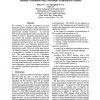Free Online Productivity Tools
i2Speak
i2Symbol
i2OCR
iTex2Img
iWeb2Print
iWeb2Shot
i2Type
iPdf2Split
iPdf2Merge
i2Bopomofo
i2Arabic
i2Style
i2Image
i2PDF
iLatex2Rtf
Sci2ools
ACL
1998
1998
Machine Translation with a Stochastic Grammatical Channel
We introduce a stochastic grammatical channel model for machine translation, that synthesizes several desirable characteristics of both statistical and grammatical machine translation. As with the pure statistical translation model described by Wu (1996) (in which a bracketing transduction grammar models the channel), alternative hypotheses compete probabilistically, exhaustive search of the translation hypothesis space can be performed in polynomial time, and robustness heuristics arise naturally from a language-independent inversiontransduction model. However, unlike pure statistical translation models, the generated output string is guaranteed to conform to a given target grammar. The model employs only (1) a translation lexicon, (2) a context-free grammar for the target language, and (3) a bigram language model. The fact that no explicit bilingual translation rules are used makes the model easily portable to a variety of source languages. Initial experiments show that it also achi...
ACL 1998 | ACL 2007 | Machine Translation | Pure Statistical Translation | Statistical Translation Models |
| Added | 01 Nov 2010 |
| Updated | 01 Nov 2010 |
| Type | Conference |
| Year | 1998 |
| Where | ACL |
| Authors | Dekai Wu, Hongsing Wong |
Comments (0)

